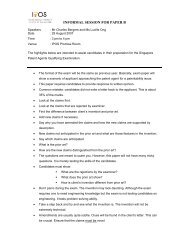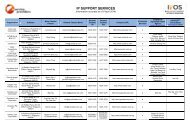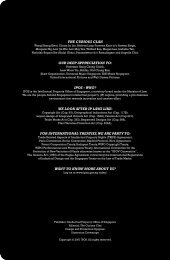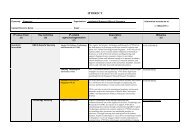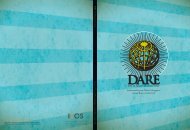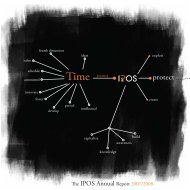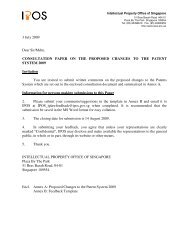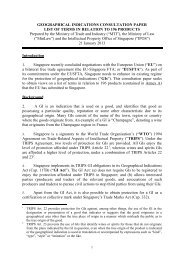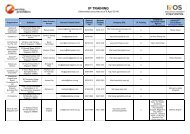Shape Marks - Intellectual Property Office of Singapore
Shape Marks - Intellectual Property Office of Singapore
Shape Marks - Intellectual Property Office of Singapore
- No tags were found...
You also want an ePaper? Increase the reach of your titles
YUMPU automatically turns print PDFs into web optimized ePapers that Google loves.
<strong>Shape</strong> marksAlthough the natural shapes <strong>of</strong> the goods in question cannot be registered, if the shapehas been the subject <strong>of</strong> substantial design input, then this objection no longer applies.For example, in Philips v Remington (Case C-299/99), Phillips’ 3-headed shavermark for “electric shavers” did not fall foul <strong>of</strong> this particular provision since the markis considered to have been subject to a substantial design input.There is some overlap between this objection and the objections on the grounds thatthe mark is devoid <strong>of</strong> distinctive character or that the mark is descriptive <strong>of</strong> the goodsor services. For example, where the trade mark is a picture <strong>of</strong> a bunch <strong>of</strong> bananas forbananas, obviously, objections can also be taken that the mark is descriptive and thus,not distinctive <strong>of</strong> the goods in question.(b) Section 7(3)(b) - <strong>Shape</strong>s that are necessary to obtain a technical resultThe purpose <strong>of</strong> this provision is to exclude shapes which are merely functional in thesense that they are motivated by and are the result <strong>of</strong> technical considerations.The ECJ in the Philips v Remington case ruled that a sign consisting exclusively <strong>of</strong>the shape <strong>of</strong> the goods is unregistrable under this provision if the essential features <strong>of</strong>that shape are attributable only to the technical result. The fact that there are othershapes which allow the same technical result to be obtained is no defence.A shape which is necessary to obtain a technical result is also likely to indicate theintended purpose <strong>of</strong> the goods, or it may be customary in the trade and therefore, nondistinctive.Thus, the grounds under Section 7(1)(b) (that the shape is devoid <strong>of</strong>distinctive character), Section 7(1)(c) (that the shape exclusively designates theintended purpose or a characteristic <strong>of</strong> the goods) and Section 7(1)(d) (that the shapeis a shape that is customary in the bona fide and established practices <strong>of</strong> the relevanttrade) would also apply.(c) Section 7(3)(c) - <strong>Shape</strong>s which give substantial value to the goodsThe purpose <strong>of</strong> this provision is to exclude “aesthetic-type shapes” (see remarks <strong>of</strong>the UK Court <strong>of</strong> Appeal in Philips v Remington), i.e., shapes which have eye appealor are purchased primarily because <strong>of</strong> the eye appeal, for example, novelty soaps,ornaments, figurines, toys, etc. The decision whether the value is substantial requires,“a comparison … between the shape sought to be registered and shapes <strong>of</strong> equivalentarticles. It is only if the shape has, in relative terms, substantial value that it will beexcluded from registration.” Any other value, for example, value due to use <strong>of</strong> betterquality materials, should be disregarded.Version 1 (13 January 2006) Page 8 <strong>Intellectual</strong> <strong>Property</strong> <strong>Office</strong> <strong>of</strong> <strong>Singapore</strong>



